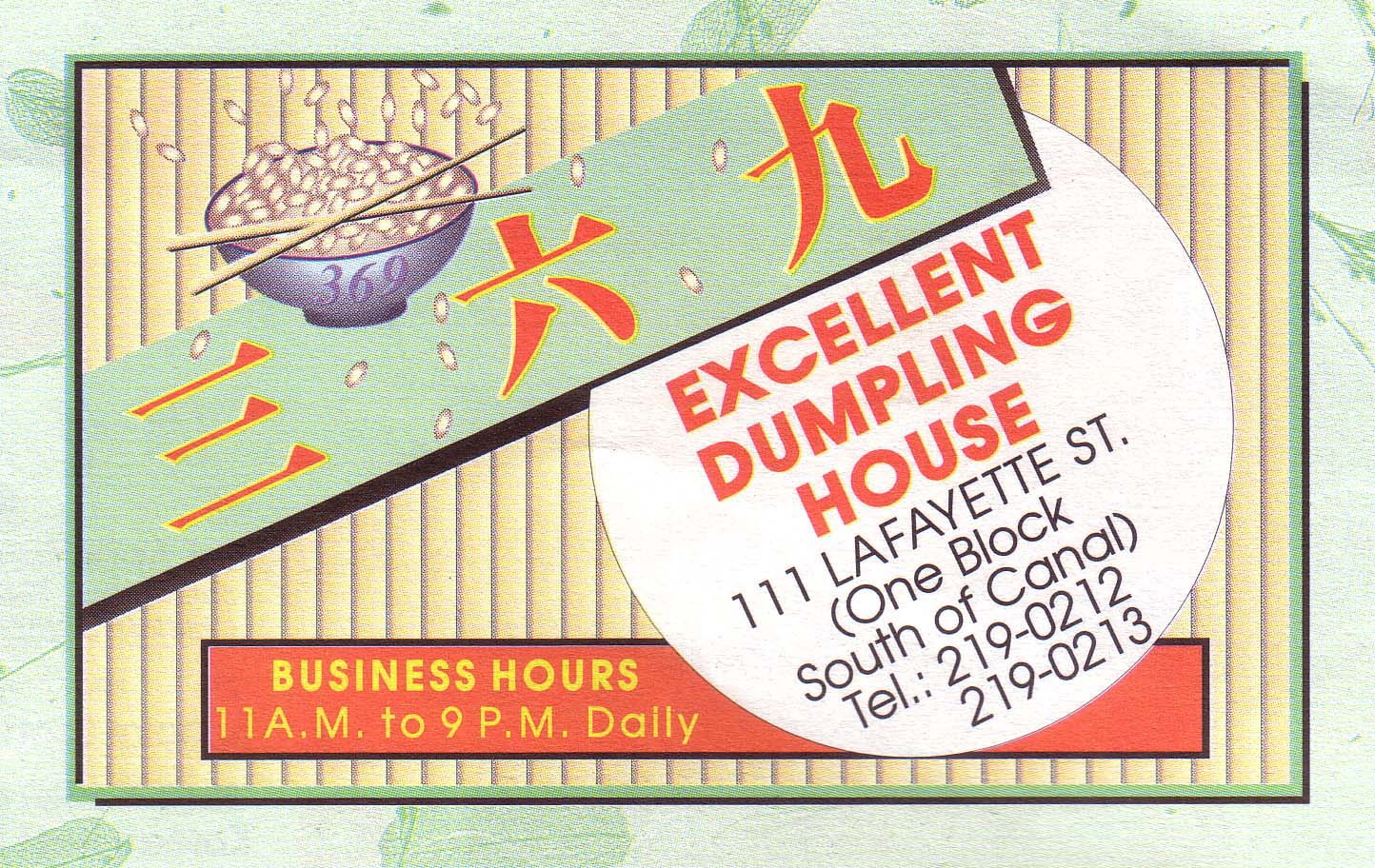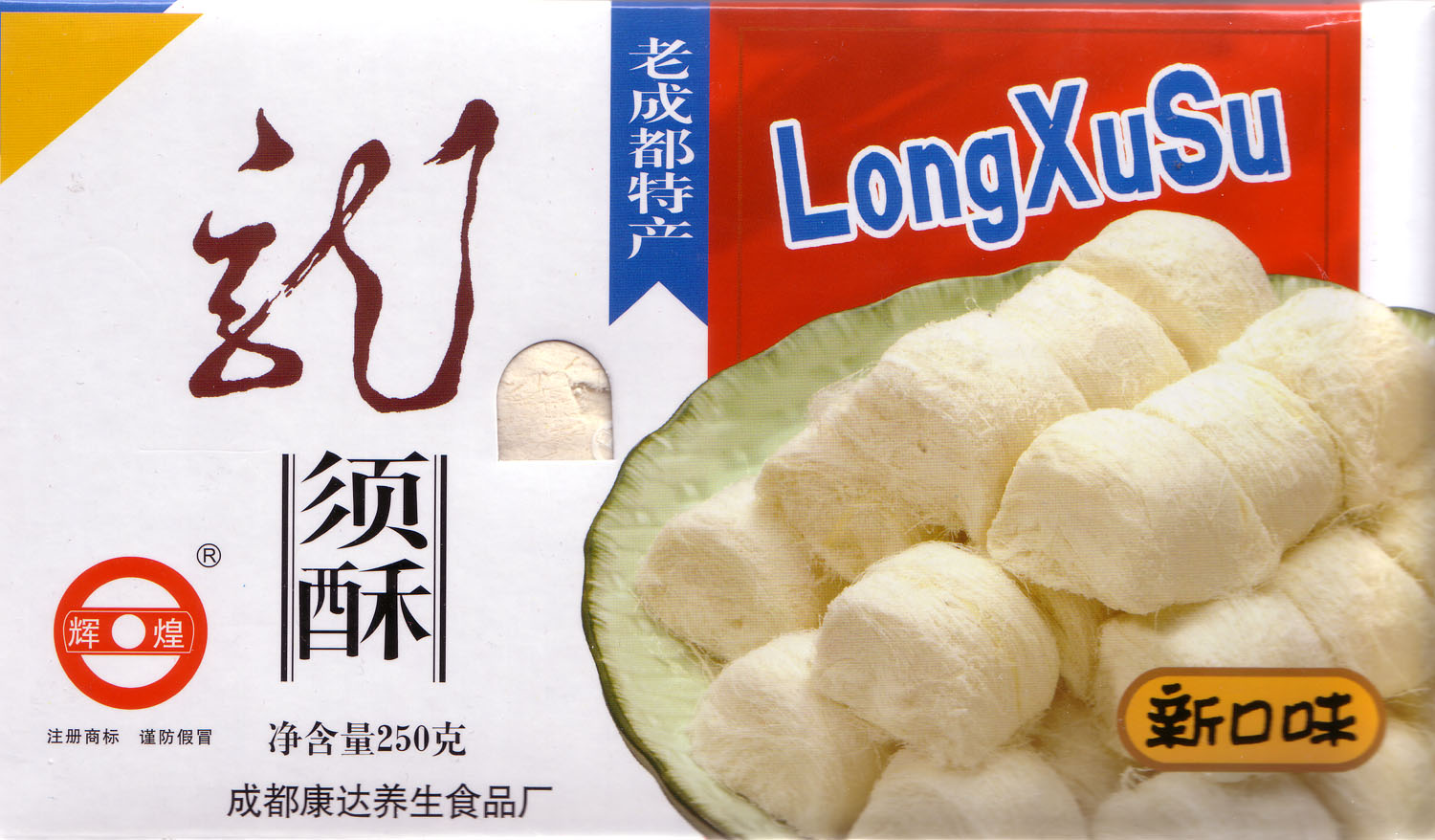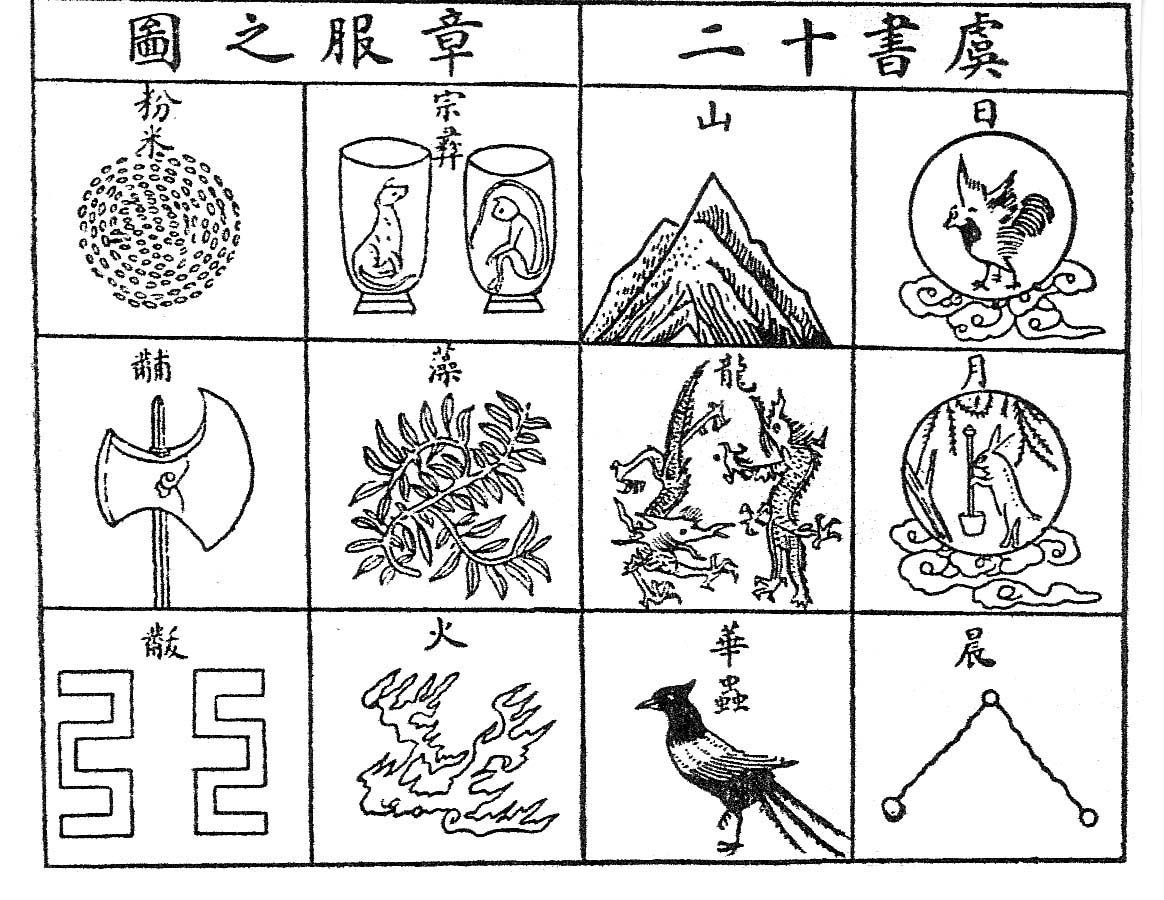
| What is Flavor and Fortune? |
| How do I subscribe? |
| How do I get past issues? |
| How do I advertise? |
| How do I contact the editor? |
Read 13092414 times
Connect me to:
| Home |
| Articles |
| Book reviews |
| Letters to the Editor |
| Newmans News and Notes |
| Recipes |
| Restaurant reviews |
| Article Index (all years, slow) |
| List of Article Years |
| Article Index (2025) |
| Article Index (last 2 years) |
| Things others say |
| Related Links |
| Log In... |
| Authors |
| Categories & Topics |
TOPICS INCLUDE: Dumplings; Dragon beard candy; Kudos; Imperial robe embroidery; Dim Sum recipes; Major cookbook collection went public; A 'Top 100' restaurant
| by Jacqueline M. Newman |
Letters to the Editor
Fall Volume: 2006 Issue: 13(3) page(s): 6, 36, and 37
 From ROSALIE in CANTON OH, via e-mail:
When I was a kid, I ate at a place on the block south of Canal Street;on Lafayette. I recall enjoying wonderful steamed and fried dumplings. My husband and I are bringing our children to New York City on their very first trip to the Big Apple. Is this restaurant still there?
From ROSALIE in CANTON OH, via e-mail:
When I was a kid, I ate at a place on the block south of Canal Street;on Lafayette. I recall enjoying wonderful steamed and fried dumplings. My husband and I are bringing our children to New York City on their very first trip to the Big Apple. Is this restaurant still there?
ROSALIE: Excellent Dumpling House; 111 Lafayette Street; New York NY 10013; phone: 212/219-0212 is still there and tell us they have been for a couple of dozen years. Their Mix Dumpling Soup is touted as one of their seven best dishes. New York City has many new and older dumpling places. We have reviewed several and suggest you try them, too. For example: Try the Dollars for Dumplings eatery found in Volume 9(4) on pages 7 and 8.
From TED via e-mail:
We tried to make the dragon beard candy (Volume 13:2 on page 30) but even with a pastry chef helping us, we are no match for Mr. Poon. Are there any commercial products available on the market?

TED: Recently, on a trip to the Hong Kong Supermarket on Main Street in Flushing, Queens, we saw our first dragon beard candy commercially packaged. It was drier than others tasted, dated but two months earlier, and had no discernable filling. With this illustration as a guide, and the picture showing the product within, hope you can find some on your coast.
From LIZZIE in Manhattan:
Noticed in the March 10, 2006 issue of Life magazine that the fruit you introduced us to in Volume 5(4) issue on pages 5 and 6 appears. This Buddha's hand citrus oddity was one of the items in Life's "Guess What's Coming To Your Kitchen" article written by Joanne Chen. You are clearly nearly ten years ahead of her pack. The author is, I assume, Chinese. Does she subscribe to your wonderful publication; if not, she should. Your readers knew about it, and where to get it, back in 1998.
LIZZIE Thank you for sharing. We are sorry not to reveal subscriber information. Should your market or others carry it, do sample it again. At the time we wrote about this popular Chinese (and other Asian) New Year fruit, there were only a few Asian markets in the United States, almost all in larger Chinatown cities, selling it. We rarely saw it in New York City. The one's we have seen and enjoyed are often larger than the seven inches in length and five pounds in weight she spoke of.
From CAROL via e-mail:
Last night I sent my husband to the mailbox with my check for renewal and he came back with the Winter issue. My favorite parts are the book reviews and the letters to the editor. I also like the articles about Chinese chefs. I would love to read about the kitchen of a Chinese restaurant and how they cook so many different things so quickly.
CAROL: Harley Spiller, our associate editor, sends the following reply:
"There was once a cartoon in The New Yorker magazine depicting a Chinese restaurant that guaranteed fast delivery. Their delivery person had a wok mounted to a bicycle, the meal cooked en route. In some ways, that matches a Boston takeout named Hop To. Jokes aside, one reason a Chinese restaurant can prepare so many different things so quickly is that Chinese cooking requires all foods to be cleaned, sliced and ready for cooking in advance. While you might crack an egg directly into a frying pan, a Chinese cook would more likely crack the egg into a bowl and have it waiting alongside other pre-prepared ingredients until the pan reaches its ideal temperature. Sometimes when you order a dish, the server who’s grown accustomed to Americans expecting lightning-fast delivery, will say in a discouraging tone, “that takes twenty minutes.” Not everything in Chinese cuisine is stir-fried in a flash. There are many casseroles and stews, for example, that go through long cooking processes--these dishes tend to be a little more expensive; require greater care; and are invariably worth the wait. Just yesterday I enjoyed such a meal, a glass dish casserole of spare rib tips slow steamed in a sour plum sauce. This morning I woke up to NYC's first snow of the season and my mind turns to a meaty, almost Germanic casserole, bo jai fun, which is white rice cooked in a clay pot with Chinese sausages and cured meats like duck leg and pork belly (also known by the deceptive English moniker, bacon). Joseph Poon, a well-known Philadelphia chef, showed me the time-saving device deployed in his and many Chinese kitchens--they have special valves on the ranges that allow them to adjust the flame with their knees. Think how much faster you’d cook if you used your arms and your legs!"
 From JEANNE in CHICAGO IL:
From JEANNE in CHICAGO IL:
Can you advise if any of the Imperial robes of the Chinese monarch were adorned with fruits or vegetables. If so, what were they?
JEANNE:Pictured on this page are the twelve sacred Imperial ornaments. One or all could be embroidered on the robes of the king. Usually only one appeared embroidered on a noble’s garment. None seem to be a specific fruit or vegetable. The first one on the left looks like rice seeds but the writing says 'rice flour.' The second one in the second row looks like leaves, and says 'seaweed.' The third one in the last row looks like a Chinese mythical bird, and its words say 'wild bird.' No one knows what the second picture in the first row or the first picture in the last row say. Can you translate them? We asked about two dozen Chinese people and none knew those characters. The last column says 'sun,' 'moon,' and 'morning.' For the record, this picture was in a volume we own called Forgotten Tales of Ancient China by Verne Dyson. It was published in Shanghai in 1934.
From THREE FOLK about Dim Sum:
We love Flavor and Fortune even when you goof. But there are so few dim sum recipes, and doubling up after the mango chicken goof, can you do likewise about the dim sum recipe omission?
To YOU THREE: Thanks to you and others who perhaps did so mentally, we appreciate compliments and complaints; and yes, we can duplicate repair a real or believed omission with a recipe from the book Dim Sum reviewed in the previous issue. We offer another, as well; both at the bottom of these letters.
From LINDA in MENLO PARK CA:
Now that I have retired from writing/editing a food magazine, I have more time to read your publication. In it are all sorts of good information about lots of exotic ingredients.
LINDA: We thank you and others who appreciate things we report about, particularly exotic ingredient materials. Many years back, we had trouble learning about some of them and do understand your comments. In your retirement, how about writing an article for Flavor and Fortune about something you are passionately interested in?
From JEFFERY via e-mail:
Your editor’s gift of cooking materials (books, etc.) to Stony Brook University made the Denver paper this week. Sounds like an amazing collection. Thank her for putting it in the public domain.
JEFFREY and OTHERS: Assume your paper provided a link to the database that can advise the titles and other information about this collection/donation. It was more than twenty-six hundred Chinese cookbooks; other materials, too. Not all publications of this information gave that valuable piece about how to use the collection even from a distance. Once again, allow me as this magazine’s editor, to suggest that interested parties visit this university’s website at www.stonybrook.edu/libspecial/collections/rarebooks And read the article by Andrew Coe in this very issue on page 19. Eventually, every volume still in use at my home will also join the Stony Brook University cookbook collection. Want to come and help annotate them?
From RALPH in Bloomfield Hills, Michigan:
My check is enclosed to renew my membership for another year. I continue to enjoy your magazine. Many thanks for your efforts.
RALPH: Thanks to you and others who pay for membership. To those who inquire as to the benefits of same; we have run a few conferences and dinners providing discounts to members. This level of extra support is one means of moving from black and white to a full-color publication. We thank those who have contributed in this manner and the others who proffer donations of various amounts.
From PHYLLIS n KINNELON NJ:
I was delighted to learn that our favorite restaurant was on the list of the Top 100 Chinese Restaurants. I have enclosed a menu of another eatery that deserves commendation. Also enclosed is a check to continue my subscription. A halt to receiving your beautifully enhanced Flavor and Fortune would be a fate too horrific to contemplate.
PHYLLIS: Double thanks. We do enjoy compliments and recommendations of great Chinese restaurants. As to the "other restaurant deserving commendation," restaurants must apply for this honor themselves. Their application needs to include items supporting this honor. Flavor and Fortune does not bestow these selections, S-B-S--the publisher of Chinese Restaurant News does. They use a scaling/rating system to assess all applications; and their applications are available in their free magazine. Tell that restaurant to search the SBS website and request one.
| Fragrant Curry Squid Chan Chen Hai |
|---|
1/2 pound very fresh squid, cleaned first, then cut into bite-sized pieces 2 teaspoons curry powder 1 teaspoon chili powder 2 petals ginger bud, minced 2 to 3 slices of fresh ginger, peeled and minced 3 cloves garlic, peeled and minced 1 Tablespoon minced leek 1 scallion, minced 1/2 teaspoon fresh chili pepper 1/2 teaspoon chopped fresh mint 1/2 teaspoon coarsely ground green peppercorns (optional) 1/4 teaspoon cornstarch 1 teaspoon spicy bean paste 1/2 teaspoon salt 1 teaspoon sugar Preparation: 1. Mix all ingredients, one by one, and then put them into a heat-proof bowl. 2. Put the bowl in a steamer over rapidly boiling water. Steam for four minutes, then serve. |
| Roast Pork Pieces |
|---|
2 Tablespoons mao tai or another strong distilled alcohol or brandy 1 inch-size lump of rock sugar mixed with two tablespoons boiling water 2 Tablespoons oyster sauce 2 Tablespoons hoisin sauce 2 squares fermented red tofu, mashed 1 teaspoon Chinese sesame-chili oil 1 pound pork loin cut lengthwise into four long strips 3 Tablespoons maltose or dark Karo-type syrup 1 pound spinach Preparation: 1. In a glass or non-reactive container, mix maotai, sugar water, oyster and hoisin sauces, mashed tofu, and chili oil, and add the pork pieces and marinate for two hours. 2. Put the drained meat strips on a rack about two inches above a deep pan filled with two inches of boiling water. 3. Bake in a 400 degree F oven for half an hour, basting them with the remaining marinade every ten minutes. 4. Remove meat to a cutting board, cut each strip into five or six thick slices and put them in a serving bowl. Bring any remaining marinade to the boil and boil it for two to three minutes, then pour it over the meat, and serve. |

Copyright © 1994-2025 by ISACC, all rights reserved
Address
3 Jefferson Ferry Drive
S. Setauket NY 11720